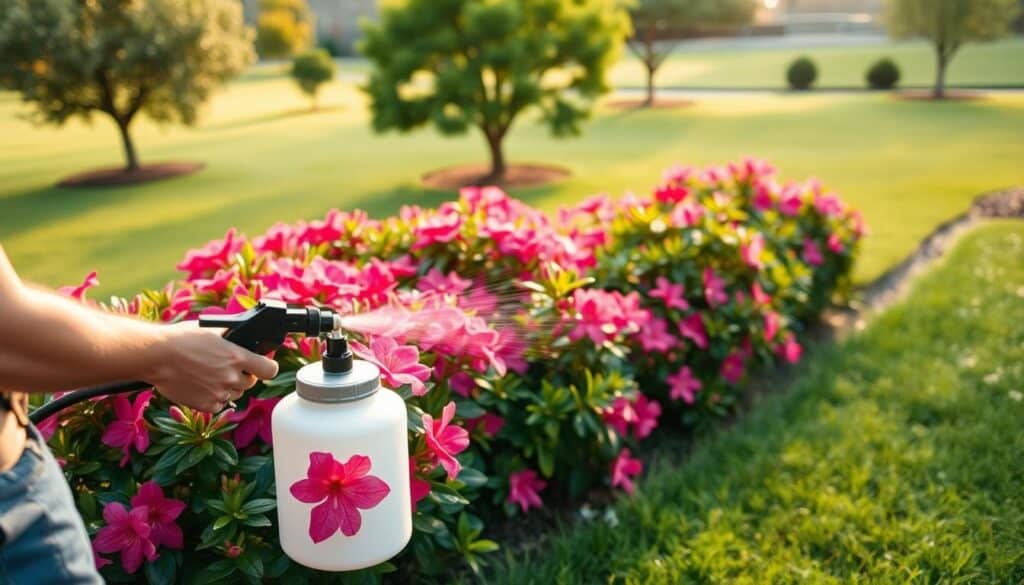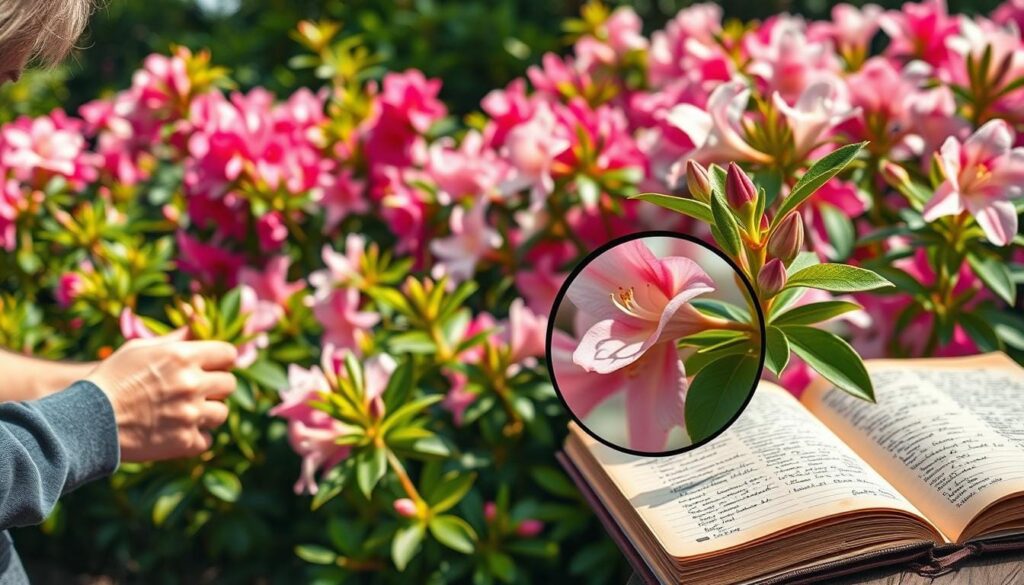I’ve seen my azaleas go from bright and full to weak and sick. Learning about azalea disease prevention has been tough but rewarding. These plants need special care to stay beautiful and healthy.
Managing azalea diseases means being proactive. These plants are usually strong but can face many challenges. Knowing how to care for them is key to keeping them safe.
Once a disease shows up, treatments don’t work well. So, it’s vital to prevent problems before they start. Buying healthy plants and taking good care of them can help a lot.
Key Takeaways
- Preventive care is essential for maintaining healthy azaleas
- Early detection of disease symptoms can save your plants
- Proper soil conditions are critical for azalea health
- Choose disease-resistant varieties when possible
- Regular monitoring helps prevent serious infections
- Proper watering techniques reduce disease risk
Understanding Azalea Diseases
Azalea diseases can harm the health and beauty of these beloved shrubs. Gardeners need to know the challenges that can affect their plants. This includes fungal infections and environmental stressors.
Managing azalea diseases starts with knowing the common problems. Fungal infections are a big challenge for keeping azaleas healthy.
Common Diseases Affecting Azaleas
- Powdery Mildew: Characterized by white powdery growth on leaves
- Petal Blight: Causes pale or rust-colored spots on flower petals
- Root Rot: Leads to stunted growth and plant decline
- Leaf Gall: Causes abnormal leaf swelling in early spring
- Twig Blight: Results in branch wilting and defoliation
Symptoms of Azalea Diseases
| Disease Type | Primary Symptoms | Potential Damage |
|---|---|---|
| Powdery Mildew | White powdery coating on leaves | Premature leaf drop |
| Petal Blight | Discolored, soft flower spots | Flower destruction |
| Root Rot | Yellowing leaves, stunted growth | Potential plant death |
It’s important to catch azalea diseases early for effective treatment. Gardeners should check their plants often. Look for changes in leaf color, flower condition, and plant vigor. Fungal infections spread fast, so quick action is key.
Environmental factors also play a big role in disease development. High humidity, poor air flow, and wrong watering can help diseases grow. Using preventative care can protect these beautiful shrubs from harm.
Causes of Azalea Diseases
Knowing why azaleas get sick is key to keeping them healthy. Things like the weather and soil can make a big difference. They decide if your azaleas will do well or fight off infections.
Many things can make it hard for azaleas to stay healthy. It’s important to follow good practices for their care. This includes fixing environmental and soil problems that can harm them.
Critical Environmental Factors
Things outside can affect how likely azaleas are to get sick. Some big issues are:
- Poor air circulation that helps fungi grow
- Too much moisture that pathogens love
- Changes in temperature that weaken plants
- How much sunlight they get and how it affects disease
Soil Conditions Impacting Plant Health
Soil is very important for azaleas to stay healthy. Certain soil problems can hurt them:
- Drainage problems that cause root rot
- Soil pH that’s not right and messes with nutrient uptake
- Soil that’s too tight and stops roots from growing
- Lack of nutrients that makes plants more vulnerable
Phytophthora root rot can kill azaleas fast if the soil is always wet. This fungus loves wet soil, showing how important good soil care is.
To manage azalea diseases well, you need to know about these issues. Gardeners should work on creating the best conditions. This means fixing drainage, keeping the right pH, and making sure air can move around.
Preventative Measures for Azaleas
Protecting azaleas from diseases needs careful azalea cultural practices. These practices focus on the best growing conditions. Understanding the plant’s needs and creating a supportive environment is key.
Keeping azaleas healthy requires attention to watering and location. Gardeners must carefully manage these factors to ensure the plants thrive.
Mastering Watering Techniques
Watering is vital for azalea disease prevention. Established azaleas need specific watering:
- Give about one inch of water per week when they’re growing
- Keep the soil moist but not too wet
- Water deeply but not often to help roots grow strong
- Use mulch to keep the soil moist and control temperature
Strategic Sunlight and Location Selection
Choosing the right spot is important for azalea health. Consider these factors:
- Look for partially shaded areas with filtered sunlight
- Avoid direct sun to prevent stress
- Make sure there’s good air flow to stop fungal growth
- Protect from harsh winter winds
“The secret to healthy azaleas lies in understanding their environmental preferences.” – Gardening Expert
By following these azalea cultural practices, gardeners can create a great environment. This environment reduces disease risks and keeps plants vibrant and healthy.
Identifying Fungal Infections
Fungal infections can harm azaleas, affecting their beauty and health. Knowing the different fungal diseases and their signs is key. This helps gardeners protect their azaleas from damage.
Types of Fungal Diseases
Azaleas face several fungal infections that can harm their growth and look. The most common include:
- Petal Blight
- Powdery Mildew
- Rust
- Cylindrocladium Leaf Spot
Signs of Fungal Infections
Spotting fungal infections early is vital to save azalea plants. Look out for these signs:
| Fungal Disease | Characteristic Symptoms |
|---|---|
| Petal Blight | Flowers become limp, slimy, and turn light brown within 2-3 days |
| Powdery Mildew | White powdery coating on leaves and stems |
| Rust | Orange-brown spots on leaf undersides |
Fungal infections in azaleas spread fast in moist conditions. Sclerotia, survival bodies of fungal pathogens like Ovulinia azaleae, can survive in diseased flowers or soil. This makes prevention key. Spotting and treating these diseases early is critical.
Keep a close eye on your plants, more so during flowering times and in humid areas. Using systemic fungicides can help. Apply them every 10-14 days, as the product’s label suggests.
Managing Bacterial Diseases in Azaleas
Bacterial diseases are a big challenge for azalea care. They are not as common as fungal infections but can harm plants a lot if not treated. Knowing how to fight bacterial infections is key to keeping azaleas healthy.
Bacterial infections in azaleas often happen in cool, wet places. These conditions are perfect for bacteria to grow and spread.
Common Bacterial Infections
There are several bacterial diseases that can hit azaleas. They might start with small signs:
- Bacterial leaf spots
- Stem cankers
- Soft rot infections
Spotting these diseases early is important. Look for discolored leaves, water-soaked spots, and plant tissue that looks off.
Treatment Options for Bacterial Diseases
Using the right azalea fungicides can fight bacterial infections. Here are some effective ways to treat them:
- Pruning infected parts
- Using copper-based bactericides
- Improving air around the plant
- Controlling moisture
Preventing disease is just as important. Keep plants clean, avoid watering from above, and choose disease-resistant azaleas to lower the risk of infection.
Pests That Affect Azaleas
Azalea pest control is key to keeping these beautiful flowering shrubs healthy. Gardeners need to watch out for pests that can harm their plants. This is important for managing azalea diseases.
Common Pests Targeting Azaleas
Many pests can harm azaleas:
- Azalea Lace Bugs: Tiny insects measuring 1/8-inch long that can produce up to three generations annually
- Spider Mites: Microscopic pests causing leaf discoloration and plant stress
- Azalea Bark Scale: Immobile insects hiding under protective egg sacs
- Azalea Caterpillars: Larvae that can quickly defoliate plants
Organic Pest Control Strategies
Effective azalea pest control uses natural methods:
- Regular plant checks for early pest signs
- Using horticultural oils for pest control
- Biological control methods
- Keeping plants healthy with good nutrition
Knowing about these pests and using the right control methods helps gardeners. They can keep their azaleas healthy and looking great all season.
Soil Management for Healthy Azaleas
Understanding soil management is key to growing healthy azaleas. The right soil conditions help prevent diseases and keep plants healthy. Azaleas need specific soil environments to thrive.
Azaleas need special soil to grow well and stay disease-free. These beautiful plants require certain conditions to flourish.
pH Levels: The Key to Azalea Vitality
Azaleas do best in acidic soil. The ideal pH range is 4.5 to 6.0. To keep the soil right, gardeners can:
- Check the soil pH regularly
- Use sulfur or acidic fertilizers to adjust pH
- Stay away from limestone or alkaline soil
- Check the soil every year
Essential Nutrient Requirements
Nutrients are vital for azalea health. These plants need specific nutrients to stay strong and fight off diseases.
“Proper nutrition is the best defense against plant diseases” – Gardening Expert
Here are the nutrients azaleas need:
- Nitrogen for leaf growth
- Phosphorus for roots
- Potassium for plant strength
- Micronutrients like iron and magnesium
By managing the soil well, gardeners can create a great environment for azaleas. This reduces disease risk and encourages healthy growth.
Seasonal Care for Azaleas
Understanding the seasonal needs of azaleas is key to their success. Proper care throughout the year keeps them healthy and vibrant. This ensures your plants bloom beautifully.
Spring Maintenance Essentials
Spring is a critical time for azalea care. Gardeners need to focus on a few important tasks:
- Prune immediately after blooming to encourage healthy growth
- Apply slow-release, acid-forming fertilizer
- Inspect plants for early signs of pest or disease development
- Mulch around the base with 2-3 inches of organic material
“The secret to thriving azaleas is understanding their seasonal rhythm,” say expert horticulturists.
Fall Preparation Strategies
As temperatures drop, preventing disease is vital. Prepare your azaleas for winter with these steps:
| Fall Task | Purpose |
|---|---|
| Reduce watering | Prevent root rot and freeze damage |
| Apply winter mulch | Protect root system from temperature fluctuations |
| Check soil pH | Maintain ideal 4.5-6.0 acidity level |
Proactive seasonal care helps azaleas withstand challenging environmental conditions and remain resilient against possible diseases.
Safe Use of Pesticides
Keeping azaleas healthy means using azalea fungicides and pest control wisely. Knowing how to apply pesticides is key. It helps keep plants safe and reduces harm to the environment.

Choosing the right pesticide is very important. Gardeners need to think about a few things when picking azalea fungicides:
- Targeted pest type
- Plant sensitivity
- Environmental conditions
- Potential impact on beneficial insects
Types of Pesticides for Azaleas
There are many pesticides for azalea pest control. Gardeners have different options:
- Systemic insecticides: Provide long-lasting protection
- Contact insecticides: Offer immediate pest elimination
- Horticultural oils: Gentle and environmentally friendly
- Biological controls: Target specific pest groups
Application Best Practices
Applying azalea fungicides needs to be done carefully. Experts suggest these steps:
- Always read product labels carefully
- Use protective equipment
- Apply during calm weather conditions
- Avoid spraying near flowering periods
- Calibrate application rates precisely
Using Integrated Pest Management (IPM) can cut down pesticide use. By watching plant health and using prevention, gardeners can fight pests. This way, they protect their azaleas.
Recognizing the Role of Pruning
Pruning is key to keeping azaleas healthy and disease-free. Knowing the right techniques and when to prune is important. This helps keep azalea shrubs looking great and staying strong.
Pruning azaleas well needs careful planning and execution. Gardeners should follow a few main principles. This ensures the plants stay healthy and look good.
Best Times for Pruning
When to prune azaleas is very important for disease control. Experts say the best times are:
- Late winter/early spring before new growth starts
- Right after they finish flowering to keep their shape
- Before July 31 to avoid messing up next year’s blooms
Pruning Techniques
Using the right pruning methods can lower disease risks and encourage growth. Here are some key tips:
- Always use clean, sharp tools to avoid spreading diseases
- Take out dead, damaged, or tangled branches
- Trim up to one-third of the branches each year
- Make cuts right above where leaves meet the stem or a branch
Azaleas can handle more pruning than many other shrubs. This lets gardeners easily control their size and shape. Regular pruning also boosts air flow, lowers humidity, and cuts down on disease risks.
Enhancing Azalea Resilience
To protect your azalea garden, plan carefully and use smart cultivation methods. Choosing the right varieties and planting them wisely can boost their health. This helps them fight off diseases better.
Preventing diseases in azaleas begins with picking the right variety. Knowing what these plants need is key. Following the right cultural practices keeps them healthy and strong.
Selecting Disease-Resistant Varieties
Picking the right azalea variety can cut down disease risks a lot. Here are some tips for choosing resilient plants:
- Choose native azalea species that fit your local climate.
- Look for varieties known to resist common fungal diseases.
- Opt for cultivars that are bred to be more disease-resistant.
Companion Planting Benefits
Using companion planting can make azaleas stronger by supporting their ecosystem. Some plants work well together, bringing many benefits:
| Companion Plant | Benefit to Azaleas |
|---|---|
| Ferns | Provide shade and keep moisture in the soil |
| Pine Trees | Help make the soil more acidic |
| Hostas | Protect the roots and keep the soil temperature right |
By using these disease prevention methods, gardeners can grow a vibrant, healthy landscape. This landscape will show off the beauty of these stunning flowering shrubs.
*”The key to successful azalea cultivation is understanding their unique environmental requirements and proactively managing possible disease risks.”*
Monitoring Azaleas Throughout the Year
To keep azaleas healthy, it’s important to watch them closely all year. Gardeners can help their plants by following a plan to track azalea care and check their health as the seasons change.

Regular Inspection Routines
Having a good monitoring plan means doing regular checks. These checks help spot problems early. Here are some important things to look for:
- Look at leaves for any color changes or spots
- Check the branches for signs of disease
- Make sure the soil isn’t too wet or dry
- Watch for pests
Keeping a Care Journal
Keeping a journal of your azalea’s health can really help. A good care journal should include:
- Date of observation
- Details about the plant’s condition
- Any treatments you’ve used
- Notes on the environment
- How the plant is growing
Keeping detailed records helps gardeners spot trends and predict problems. This way, they can take action early to keep their azaleas healthy. Regular checks help gardeners stay ahead of any issues and keep their plants thriving.
Resources for Azalea Disease Management
Managing azalea diseases needs good resources and expert advice. Local extension services are key for gardeners looking for advice on azalea care. They connect you with experts who know your area’s climate and azalea challenges.
Online forums and communities are great for azalea lovers to share tips and learn about disease prevention. Websites focused on plant health have discussion boards for talking about issues like powdery mildew and pests. You can also find detailed guides on azalea disease management on university and botanical garden websites.
Now, there are mobile apps and webinars for quick advice on azalea care. You can find info on fungal infections, pest control, and keeping azaleas healthy. Using these resources, gardeners can create strong plans to protect their azalea gardens all year.
Extension Services and Local Experts
State university agricultural extension offices are vital for local azalea care advice. They offer specific tips for managing diseases in your area and suggest treatments based on your environment.
Online Communities and Forums
Digital spaces like GardenWeb, Reddit’s gardening groups, and azalea forums are perfect for sharing knowledge and solving plant health problems. These places keep gardeners updated on the latest in azalea care and disease management.

